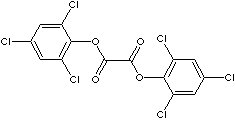PRODUCT IDENTIFICATION

2917.11
CLASSIFICATION
PHYSICAL AND CHEMICAL PROPERTIES
white crystalline powder
188 - 192 C
REFRACTIVE INDEX
GENERAL DESCRIPTION & APPLICATIONS
Some Chemoluminescence related compounds include:
- Bis(2,4,5-trichlorophenyl-6-carbopentoxyphenyl) oxalate (CAS #: 30431-54-0)
- Bis(2,4,6-trichlorophenyl) Oxalate (CAS #: 1165-91-9)
- Bis(2,4-dinitrophenyl) Oxalate (CAS #: 16536-30-4)
- 9,10-Bis(phenylethynyl)anthracene (CAS #: 10075-85-1)
- 9,10-Diphenylanthracene (CAS #: 1499-10-1)
- Rubrene (CAS #: 517-51-1)
- Bis(2-carbopentyloxy-3,5,6-trichlorophenyl)oxalate (CAS #: 75203-51-9)
- N-(4-Aminobutyl)-N-ethylisoluminol (CAS #: 66612-29-1)
- Luminol (CAS #: 521-31-3)
- Isoluminol (CAS #: 3682-14-2)
- 5,12-Bis(phenylethynyl) naphthacene (CAS #: 18826-29-4)
- 2-Chloro-9,10-bis(phenylethynyl) anthracene (CAS #: 41105-36-6)
- 1,8-Dichloro-9,10-bis(phenylethynyl) anthracene (CAS #: 51749-83-8)
- Lucifer Yellow CH dipotassium salt (CAS #: 71206-95-6)
- Lucifer yellow VS dilithium salt (CAS #: 71231-14-6)
- Lophine (CAS #: 484-47-9)
- Rubrene (CAS #: 517-51-1)
- Tetrakis(dimethylamino)ethylene (CAS #: 996-70-3)
- Luciferins (Firefly luciferin, Bacterial luciferin, Dinoflagellate luciferin, Vargulin)
- Coelenterazine
- 2-(4-Dehydroxy) coelenterazine
APPEARANCE
yellow to greenish crystalline powder
98.0% min
188 - 192 C